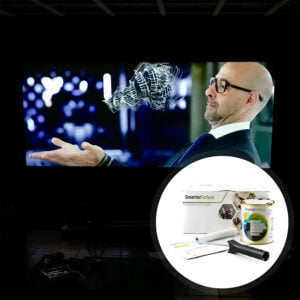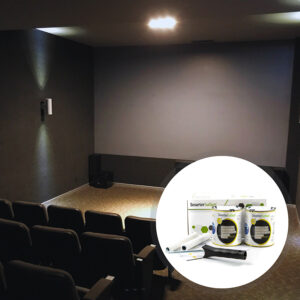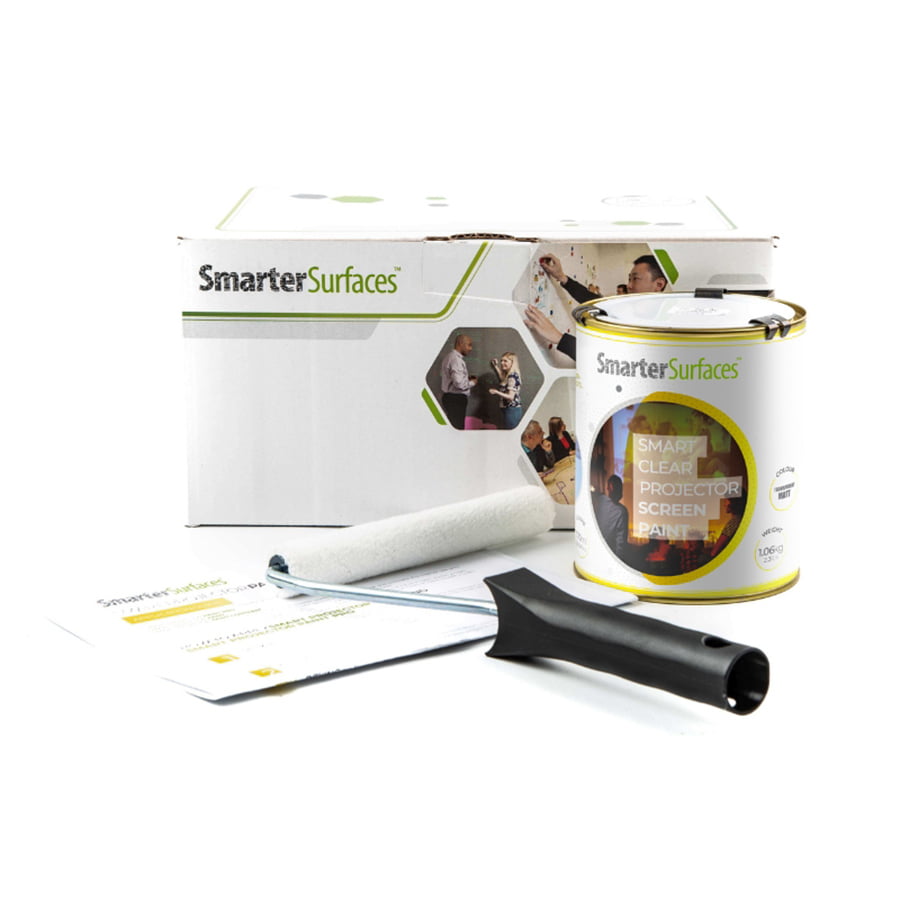Benefits of Using Smart Ambient Light Rejecting Paint (ALR Screen)
Advanced Ambient Light Rejection
Ambient Light Rejecting Paint minimizes unwanted light interference, selectively bouncing back projector light while diffusing excess light, thereby enhancing image clarity in well-lit spaces.Enhanced Picture Reproduction
Engineered to optimize pixel clarity, definition, and ambient light rejection, it provides bright, high-definition visuals for home theater and gaming environments.Specular & Diffuse Reflection Reduction
Ultra matte layering technology eliminates both specular and diffuse reflection, minimizing stray light and maintaining image integrity.Ideal Projection Efficiency
Evaluated with industry-grade projectors to guarantee no hotspotting or degradation of performance on standard material surfaces.Simple Application and Streamlined Appearance
Fast and easy application for discreet projection functionality, preserving a clean and sleek look in home theater settings.For Use With
- Projector Requirements: Interactive, HD, 4K, Standard Projectors
- Minimum Recommended Lumen Value: 2,000 Lumens
- Lighting: works in most rooms with normal to high ambient light
- Compatible Surfaces: can be applied to fabrics and is suitable for painting or refurbishing old screens, but not suitable for roll-up screens
Performance
- 4K & 8K Ultra HD Ready
- Gain Value @ 90 °: 0.71
- Viewing Angle: 140 degrees
- Certification: Independent Projection Performance Report – CREST
Comparison Table
Compare the performance and specifications of our full projection range
ALR Screen Paint - Technical Specifications
Colour: Light Grey
Finish: Ultra Matte
Screen Size:
- 4.5 m² : 3.05 m at 16:9 Aspect Ratio
- 25 m² : 7.65 m at 16:9 Aspect Ratio
Volume:
- 48 ft2 : 29.75 fl oz
- 270 ft2 : 169.07 fl oz
Coverage:
- 4.5 m² : 2.79m × 1.57m at 16:9 Aspect Ratio
- 25 m² : 6.67m × 3.75m at 16:9 Aspect Ratio
Environmental (exceeds all Canadian standards): low VOC, Solvent free, PFOA & PFOS free and Isocyanates free
Odour: Very Low
VOC: Less than 0.33%
Certification: Independent Projection Performance Report – CREST, Gypsum Surface Finish Quality Standard of Level 5
Not sure which product is right for you? We provide video call assistance, live chat, phone, and email service. Get the advantage of free technical assistance, ideas, and product suggestions to help you find what works best for you. Confused about the installation procedure? We are here to help you.
Ambient Light Rejecting – Kit Contents 4.5 m²
1x ALR Screen Paint
1x White Primer
1x Roller
1x Roller Handle
1x Application Guide
Ambient Light Rejecting – Kit Contents 25 m²
1x ALR Screen Paint
1x Application Guide
Ambient Light Rejecting Paint Reviews
MAC AV Solutions
Fyco Montreal
Winnipeg AV
Explore More Products From Smarter Surfaces
- (0 Reviews)
Black Projector Screen Paint For High Contrast Projection
From CAD$314.00 Select options This product has multiple variants. The options may be chosen on the product page - (0 Reviews)
High Contrast Projector Screen Paint for Enhanced Visuals
From CAD$314.00 Select options This product has multiple variants. The options may be chosen on the product page - (0 Reviews)
Ultra High Contrast Projector Screen Paint – Grey Matte
From CAD$329.00 Select options This product has multiple variants. The options may be chosen on the product page - (0 Reviews)
Clear Projector Screen Paint
From CAD$284.00 Select options This product has multiple variants. The options may be chosen on the product page
FAQ's
The gain value reflects the quantity of lumens the screen can reflect. A higher gain value indicates that more light is reflected, resulting in a brighter image on the screen. In contrast, a lower gain value results in less light being reflected, leading to a dimmer image.
The gain value also affects the viewing angle's width. A screen with a higher gain will offer a narrower viewing angle, requiring viewers to be positioned more directly in front of the screen for optimal brightness. Conversely, a screen with a lower gain provides a wider viewing angle, allowing for a brighter image to be seen even when not directly facing the screen.
It's essential to consider that the ideal gain depends on the specific viewing conditions and the desired experience. Elements such as ambient lighting, screen size, projector brightness, and audience arrangement all influence the best gain for a particular scenario.
The effective blending of projections demands precise colour fidelity, consistent brightness, and superior light diffusion to ensure a smooth flow between the projected visuals. Our projection screen paint was designed with these elements in mind, enabling you to create a unified and immersive display.
For large-scale screens, our projection screen paint removes the necessity for bulky and costly physical screens, offering a more adaptable and budget-friendly option for blending projections. Transform any area into an engaging canvas where multiple projections seamlessly integrate, captivating your audience.
Thus, the projection screen you use mustn't alter the polarity of the light when using a 3D projector. All of our paint products are "polarity preserving," meaning the image you observe will maintain the intended polarity, ensuring the full 3D effect is preserved.
The SAC can fluctuate with the frequency of the sound waves traveling through the material. Different sound wave frequencies have varying wavelengths, which interact with the material in distinct ways. Consequently, the SAC values provided represent a range, as the SAC will differ based on the frequency of the sound waves being absorbed. In our assessments, we recorded the following findings:
Unpainted Board α = 0.04-0.07
Painted Board α = 0.04-0.07
The values listed pertain to both an unpainted 12mm gypsum board and a painted version. The α values of 0.04-0.07 for both types signify the range of SAC values for these materials. This indicates that when sound waves travel through a 12mm gypsum board, some sound energy will be absorbed by the material, with the absorption amount falling within the 0.04-0.07 range, depending on the sound wave frequency. However, it also suggests that all our paints are acoustically transparent, as there is no difference in performance between the standard board and the painted version.
All surfaces preparing for painting should be dry, clean, and free from any loose materials. Measure the area you intend to paint and clearly outline it with masking tape unless you are painting an entire wall. Apply a primer coat to uncoated, bare surfaces with a layer of White Primer.
Repair any defects or cracks and sand the entire surface smooth using 120-grade sandpaper or similar. Thoroughly stir the projector paint before applying it. For optimal results, apply the paint with a mohair or lint-free short pile roller sleeve.
ALR paint complies with the most stringent environmental guidelines and has been independently certified for fire safety and VOC levels. As with any painting product, we advise wearing gloves during the application process.
Ambient Light Rejecting Paint Installation
Ambient Light Rejecting Projector Screen Paint is appropriate for application on surfaces like plaster, wood, concrete, metal, wallboards, and various composites. It is meant for indoor use only.
Before painting, ensure all surfaces are clean, dry, and free from any loose materials. Measure the area you plan to paint and clearly outline it using masking tape.
For bare or untreated surfaces, apply a coat of White Primer as a base. After priming, lightly sand the surface, then use a mohair or lint-free short pile roller sleeve to apply the first coat. Allow this coat to dry before adding the second.
After 24 hours, our Ambient Light Rejecting Paint will be ready for use.
If you're interested in experiencing the performance of our products, you can request a sample pack.
Should you have any inquiries or require guidance, we take pride in offering excellent customer service and support. Feel free to reach out to us.
![]() A full application guide to help you apply our Ambient Light Rejecting Paint.
A full application guide to help you apply our Ambient Light Rejecting Paint.
Ambient Light Rejecting Paint installation Video
Watch our step-by-step Video Application Guide
Ambient Light Rejecting Paint Videos
Watch our step-by-step Video Application Guide
Whiteboard Paint White for Education
Whiteboard Paint White Case Study

















